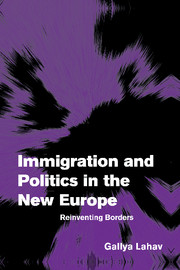Book contents
- Frontmatter
- Contents
- List of figures and tables
- Preface and acknowledgments
- 1 Introduction
- 2 Toward a people's Europe: an institutional analysis of immigration policy in the European Union
- 3 An attitudinal portrait of a people's Europe: a comparative overview of public opinion and elite preferences
- 4 Immigration politics and the new Europe: organizing competing interests
- 5 The “European factor”: institutional and psychological constraints on immigration attitudes
- 6 Conclusions: the construction of a European immigration regime?
- Appendices
- A Data collection and methodology
- B Comparing different measures of attitudes
- C Questionnaire and survey
- D National policy variations in EU countries
- E EU country profiles
- F Selected Eastern and Central European country profiles
- Bibliography
- Index
A - Data collection and methodology
Published online by Cambridge University Press: 18 December 2009
- Frontmatter
- Contents
- List of figures and tables
- Preface and acknowledgments
- 1 Introduction
- 2 Toward a people's Europe: an institutional analysis of immigration policy in the European Union
- 3 An attitudinal portrait of a people's Europe: a comparative overview of public opinion and elite preferences
- 4 Immigration politics and the new Europe: organizing competing interests
- 5 The “European factor”: institutional and psychological constraints on immigration attitudes
- 6 Conclusions: the construction of a European immigration regime?
- Appendices
- A Data collection and methodology
- B Comparing different measures of attitudes
- C Questionnaire and survey
- D National policy variations in EU countries
- E EU country profiles
- F Selected Eastern and Central European country profiles
- Bibliography
- Index
Summary
The opinion data in this research derive from two sources: mass surveys and profiles of elite attitudes. Each is described below.
Public opinion data
The public opinion data come from Eurobarometer studies provided by the Inter-university Consortium for Political and Social Research (ICPSR), located at the University of Michigan. In 1974, the Commission of the European Communities initiated the series, designed to provide regular monitoring of social and political attitudes of the publics within the EU. These have generated longitudinal and comparative data on controversial issues, including immigration, xenophobia, and race, as well as European integration. They are used here to provide some comparative context for national, ideological, and other polarizations that have evolved over the post-World War II period. Conducted biannually, these surveys consist of batteries of items repeated each year as well as special topics. Since the special issue on immigration and xenophobia in 1988/89, the spring Eurobarometer has consistently included a few questions related to immigration and immigrant groups. Not all questions are asked each year.
Eurobarometers 30, 35, 36, 37, 38, 38.1, 39, 40, 41, 42, 43.1, 44.2, 46, 47.1, 47.2, 48, 49, and 50 were most useful for this study.
- Type
- Chapter
- Information
- Immigration and Politics in the New EuropeReinventing Borders, pp. 232 - 242Publisher: Cambridge University PressPrint publication year: 2004

